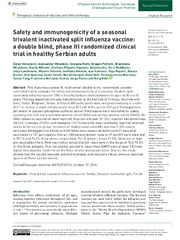Приказ основних података о документу
Safety and immunogenicity of a seasonal trivalent inactivated split influenza vaccine: a double blind, phase III randomized clinical trial in healthy Serbian adults
| dc.creator | Stevanović, Goran | |
| dc.creator | Obradović, Aleksandar | |
| dc.creator | Ristić, Snezana | |
| dc.creator | Petrović, Dragan | |
| dc.creator | Milenković, Branislava | |
| dc.creator | Mitrović, Danilo | |
| dc.creator | Vignjević Filipović, Svetlana | |
| dc.creator | Ilić, Katarina | |
| dc.creator | Stoiljković, Vera | |
| dc.creator | Lavadinović, Lidija | |
| dc.creator | Pelemis, Mijomir | |
| dc.creator | Petrović, Svetlana | |
| dc.creator | Vidmanić, Ana | |
| dc.creator | Popović, Olga | |
| dc.creator | Eremić, Natasa | |
| dc.creator | Sparrow, Erin | |
| dc.creator | Torelli, Guido | |
| dc.creator | Socquet, Muriel | |
| dc.creator | Holt, Renée | |
| dc.creator | Ilieva-Borisova, Yordanka | |
| dc.creator | Tang, Yuxiao | |
| dc.creator | Scorza, Francesco Berlanda | |
| dc.creator | Flores, Jorge | |
| dc.creator | Rathi, Niraj | |
| dc.date.accessioned | 2022-02-22T08:48:50Z | |
| dc.date.available | 2022-02-22T08:48:50Z | |
| dc.date.issued | 2020 | |
| dc.identifier.issn | 2515-1355 | |
| dc.identifier.uri | http://intor.torlakinstitut.com/handle/123456789/616 | |
| dc.description.abstract | This study was a phase III, multicenter, double-blind, randomized, placebo-controlled trial to evaluate the safety and immunogenicity of a seasonal trivalent split, inactivated influenza vaccine (TIV) in healthy Serbian adults between the ages of 18 and 65 years. This egg-based vaccine was manufactured by the Institute of Virology, Vaccines and Sera, Torlak, Belgrade, Serbia. A total of 480 participants were assigned randomly in a ratio of 2:1 to receive a single intramuscular dose (0.5 ml) of the vaccine (15 µg of hemagglutinin per strain) or placebo (phosphate-buffered saline). Participants were monitored for safety, including solicited and unsolicited adverse events (AEs) and serious adverse events (SAEs). No SAEs related to vaccination were reported. Injection site pain (51.3%), injection site tenderness (40.4%), tiredness (17.0%), and headache (15.1%) were the most commonly reported solicited events in the vaccine group. Incidence of related unsolicited AEs was low (1.3%) among vaccinees. Hemagglutinin inhibition (HAI) titers were measured before and 21 days after vaccination in 151 participants. Overall, HAI seroconversion rates to H1 and H3 were observed in 90.1% and 76.2% of vaccinees, respectively. For B antigen, it was 51.5%, likely due to high pre-vaccination titers. Post-vaccination seroprotection rates were in the range of 78.2–95.0% for the three antigens. Post-vaccination geometric mean titers (GMT) were at least 3.8 times higher than baseline levels for all the three strains among vaccinees. Overall, the study showed that the vaccine was safe and well tolerated, and induced a robust immune response against all three vaccine strains., ClinicalTrials.gov identifier: NCT02935192, October 17, 2016 | |
| dc.language | en | |
| dc.publisher | SAGE Publications | |
| dc.relation | US Department of Health and Human Services/BARDA grant Number IDSEP130015-01 | |
| dc.relation | US Department of Health and Human Services/BARDA grant Number IDSEP130018-01-06 | |
| dc.relation.isreferencedby | https://hdl.handle.net/21.15107/rcub_intor_637 | |
| dc.rights | openAccess | |
| dc.rights.uri | https://creativecommons.org/licenses/by-nc/4.0/ | |
| dc.source | Therapeutic Advances in Vaccines and Immunotherapy | |
| dc.subject | clinical trial | |
| dc.subject | seasonal influenza vaccine | |
| dc.subject | Serbia | |
| dc.subject | Torlak | |
| dc.subject | trivalent inactivated split | |
| dc.title | Safety and immunogenicity of a seasonal trivalent inactivated split influenza vaccine: a double blind, phase III randomized clinical trial in healthy Serbian adults | |
| dc.type | article | en |
| dc.rights.license | BY-NC | |
| dc.citation.volume | 8 | |
| dc.description.other | Supplementary information: [https://hdl.handle.net/21.15107/rcub_intor_637] | |
| dc.identifier.doi | 10.1177/2515135520925336 | |
| dc.identifier.fulltext | http://intor.torlakinstitut.com/bitstream/id/1273/2515135520925336.pdf | |
| dc.identifier.scopus | 2-s2.0-85118420286 | |
| dc.type.version | publishedVersion |

